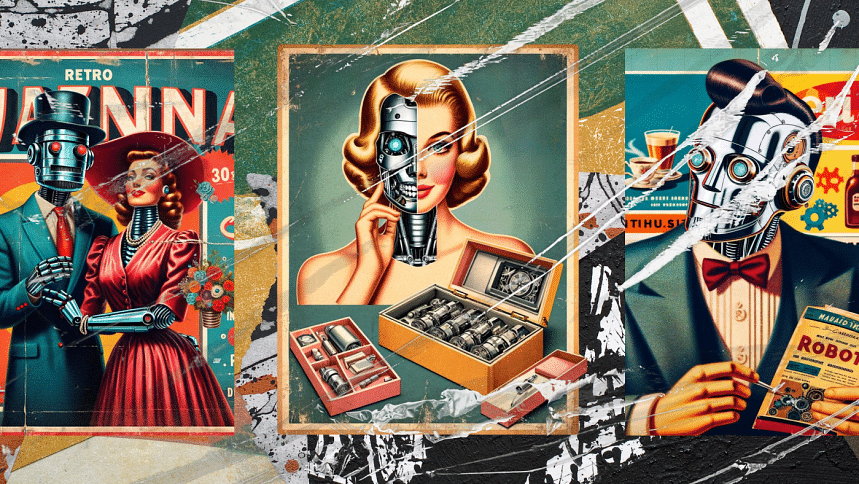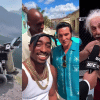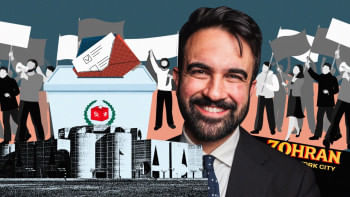A trend on the rise: The phenomenon of AI-generated advertisements

Artificial Intelligence (AI) has rapidly transformed various sectors, and advertising is no exception. With advancements in deep learning algorithms and neural networks, modern AI has become increasingly proficient in generating realistic imagery, including ad campaigns without human intervention. Recent advertisements inside Dhaka Metro Rail show how local brands have also started adopting this new trend.
One of the key advantages of AI-generated advertisements is their cost-effectiveness. Hiring creative teams for every ad variation can be expensive. AI, however, can churn out multiple iterations at a fraction of the price. This cost savings allows brands to reallocate resources towards other areas of their business, such as product development or customer service, ultimately driving long-term growth and profitability.
"Traditional ad shoots, with their extensive requirements for actors, crew, and logistical arrangements, incur substantial expenses. In contrast, a subscription to AI-based image generation models slashes costs by over 80%, primarily by eliminating the need for elaborate setups and personnel," explained Sabbir Islam, CEO of Wire Digital Multimedia Marketing.
This cost-saving allows brands to reallocate resources towards other areas of their business, such as product development or customer service. However, since AI deployment in advertising is very slow and only used by a small fraction of brands, job cuts aren't a worry - at least so far, according to experts.
AI offers a kind of speed and efficiency that allows brands to meet tight deadlines and respond to market trends with incredible agility. Automating the image generation process allows brands to streamline workflow and iterate rapidly on creative concepts. This efficiency also means that brands can reallocate resources to other critical tasks while maintaining a competitive edge in a dynamic marketplace. AI also allows for the rapid generation of multiple variations of advertisements, making it easier to test and optimise campaigns for maximum effectiveness. "This scalability is particularly advantageous for local brands looking to expand their reach and market presence as it expedites the campaign turnaround time," shared Drabir Alam, COO and Director at X.
One such example is a video ad for Cadbury featuring the famous Indian actor Shah Rukh Khan asking viewers to shop at 2000 local stores during Diwali. This campaign not only boosted audience engagement but also leveraged the power of personalised communication to generate word-of-mouth buzz.
One key factor for consideration is ensuring relevance across diverse cultural landscapes. "It is essential to tailor content to resonate with varied audiences, emphasising the significance of understanding audience preferences. Additionally, maintaining brand guidelines is imperative, necessitating human intervention to ensure alignment and consistency throughout content creation processes," added Asharful Alam Sarker, CEO of Leads For You.
At the same time, AI can dynamically adjust content based on engagement metrics, ushering in a new era of interactive and experiential marketing. "Brands can tailor content in real-time to optimise audience engagement, thereby enhancing the overall effectiveness of their marketing efforts," he added. This shift signifies a fundamental evolution in consumer interaction, paving the way for more immersive brand experiences and deeper connections with audiences.
Take the case of Nestle's Milkmaid. Inspired by the Rijksmuseum's viral use of X-ray technology to reveal hidden details in Vermeer's "The Milkmaid" painting, WPP created an AI-generated ad campaign for Nestle. Using DALL-E 2, they revealed their own imagined scenes beyond the frame of the painting. This creative approach resulted in a highly successful campaign, generating a media value of 700,000 euros for Nestle through almost 1,000 ad iterations. Beyond commercial success, this campaign witnessed the convergence of art, technology, and storytelling in contemporary advertising, showcasing the transformative potential of AI to not only captivate audiences but also to reimagine the possibilities of brand communication.
While AI advertising holds immense promise, its long-term effectiveness is still under scrutiny. One such concern is the potential for two competing brands to inadvertently use the same AI-generated character—a scenario virtually inconceivable in traditional advertising settings. Unlike the controlled environment of a photo shoot or casting session, where each brand meticulously crafts its distinct visual identity, AI-generated imagery introduces an element of unpredictability. While this lack of control may seem daunting, it also sheds light on the democratising force of AI in advertising, levelling the playing field for brands of all sizes.
Will AI-generated ads continue rising in popularity? Seems likely at this point.

 For all latest news, follow The Daily Star's Google News channel.
For all latest news, follow The Daily Star's Google News channel. 








Comments